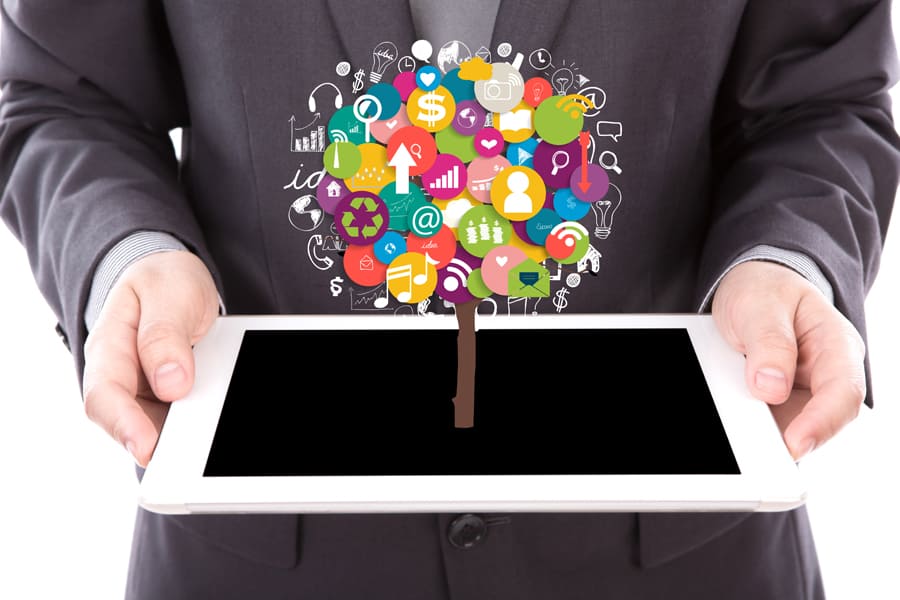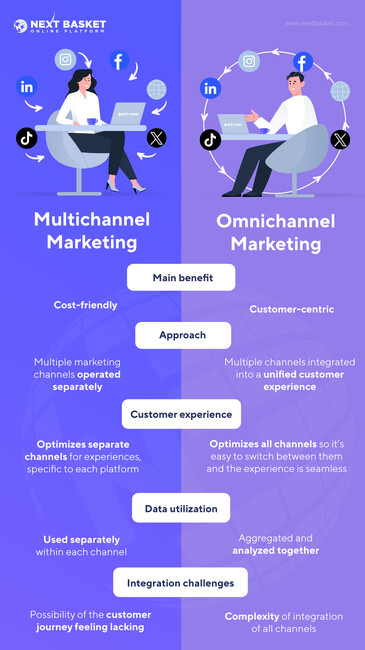Digital marketing is far from being one-dimensional advertising; it’s complex and multi-layered, with strategies involving a sleuth of channels that provide a personalized customer experience.
As businesses strive to reach potential customers wherever they are, the terms multichannel and omnichannel have become buzzwords in the industry. But what are they exactly, and how do they differ?
This article dissects the intricate details of both approaches, revealing key differences between them and guiding you on how to develop effective strategies for each one.
Introduction to multichannel and omnichannel marketing
Times define how businesses deal with potential customers. With the advent of digital sales channels such as online platforms and mobile devices, physical stores no longer limit the reach of businesses. Along with that, the need to be present in multiple places simultaneously has become imperative.
And this is where multichannel marketing and omnichannel marketing take their rightful place on the stage.
The multichannel strategy involves reaching customers through separate channels. Whether it’s an email campaign, a Facebook ad, or an in-store promotion, each channel operates independently.
This approach focuses on broadening the reach and increasing brand visibility. However, it may lack cohesion and personalization in the customer journey.
On the contrary, the omnichannel approach (omni, meaning all) aims to unify all channels (online and offline) in order to provide a personalized journey for the customer. It considers every channel as an interconnected part of a whole – one that offers a consistent and seamless experience across all touchpoints.
This makes for a more customer-centric where you look at everything as an element within the full customer experience, in contrast to the multichannel approach focusing on a particular channel before looking at another separate channel, and so on.

Understanding the concept of multichannel marketing
To better understand how multichannel vs omnichannel work, let’s boil down each approach to its fundamental concepts, starting with the former.
It uses multiple channels to reach the target audience. Digital platforms like websites and social media, traditional media like TV, and even physical stores all serve to make that work.
Each marketing channel operates independently. The Facebook ad campaign might not be connected to the email marketing strategy, and neither may it align with the brick-and-mortar store promotions.
Marketing messages are tailored to the audience of a specific channel. This means that the content and offers are designed to fit that unique channel and resonate with its unique audience.
Since the channels operate separately, in some cases, there may be a lack of consistency in the customer’s journey. Should this happen, it might lead to confusion or a disjointed perception of the brand.
Tracking customer behavior and customer engagement across separate channels can be a complete mess unless done right. That being the case, as of late, intricate tools like Trackian and Owox have taken on the challenge of facilitating the process of gathering customer data from and connecting the dots between different platforms.
On the one hand, we have flexibility and brand reach. On the other hand, we have potential inconsistencies in the brand image and customer experience.
Understanding these dynamics is crucial to devising a multichannel that is truly effective.
Key features and benefits of multichannel marketing
Now that you know what multichannel marketing is all about, let’s check out the leading features and benefits for businesses.
Here is a short list of them:
- Lower costs. Managing separate channels requires less of a financial investment, making this the budget option.
- Channel-specific targeting. With the independence of channels, you craft unique strategies and messages that are meant for the user base of a specific channel.
- Flexibility in approach. Marketers get to experiment with many strategies on many channels and can quickly adapt to changes in separate market landscapes.
- Increased brand visibility. Potential customers across multiple platforms gain more visibility over your brand, making it feel more familiar.
- Potential for growth and experimentation. Just as with anything else, when it comes to e-commerce, multichannel retailing can produce desired results when executed by an expert team that knows the strong and weak points of each step along the way.
While there are many merits, there are some challenges in integration, such as the lack of a unified view that can affect the way messages and customer experiences are built.

Examples of successful multichannel marketing campaigns
Multichannel marketing is about communicating with customers across multiple platforms, online and offline. So, who knows how to do it successfully?
Nike – “Dream Crazy” Campaign
- Channels used: Social media, video ads, outdoor billboards.
- Overview: Nike partnered with Colin Kaepernick to deliver a powerful message for everyone everywhere. The campaign included social media posts, a YouTube video commercial, and outdoor billboards. The message spread like wildfire, even if there wasn’t anything to personalize the experience or make it seamless for individual users and customers.
Univeler’s Axe – “Find Your Magic” Campaign
- Channels used: TV, print, digital ads, YouTube, social media.
- Overview: Axe’s campaign encouraged men to embrace their individuality. All the marketing channels targeted different segments of the audience. TV reached a broad audience, print targeted specific publications, and digital channels like YouTube allowed for more engagement.
Procter & Gamble – “Thank you, Mom” Campaign
- Channels used: TV, YouTube, print, social media.
- Overview: This campaign celebrated mothers worldwide during the Olympic Games. P&G utilized different channels to reach various audience segments. Through each one, they provided unique perspectives, and while the messaging was consistent, the journey wasn’t because it was adapted to best fit each platform.
Spotify – “Wrapped” Campaign
- Channels used: Mobile app, social media, email.
- Overview: Spotify’s annual Wrapped campaign celebrates users’ listening habits, delivering personalized insights through their mobile app, email, and social media sharing. It’s become a highly anticipated event, driving user engagement and promoting the Spotify brand.
How to develop an effective multichannel marketing strategy?
Before we give you a broad outline of how to develop your own multichannel marketing strategy that’s effective, there’s something we need to talk about – what a multichannel marketing strategy is and what it isn’t.
Firstly, it doesn’t unite the channels into a single flowing experience; it separates them and communicates the same message in different ways.
Secondly, it is done across multiple channels that spread the same message. They don’t intersect along the way because every channel functions on its own without considering others, so naturally, even then, the experience is like a layered cake and not a flat one.
Now, let’s break down the process of developing a multichannel strategy:
- Identify your channels. Start by choosing the channels you will be actively promoting your campaign on. Be it social media, a contact center, or a physical store – choose the precise locations where you will put emphasis on your marketing efforts.
- Develop channel-specific strategies. Consider the preferences and behaviors of the specific audience on that particular platform. This could mean your messaging, visuals, or offers might differ a bit so that they are closer to what customers expect.
- Integrate where possible. Separate channels don’t mean entirely separate messaging. Great campaigns integrate their messaging on as many platforms as possible to enhance the customer experience.
- Track and analyze performance. Use your analytics tools to track the performance of each channel so that you understand what drives engagement on each one.
- Ensure brand consistency. While customizing the approach for each channel, the core brand message and brand identity have to remain consistent. This helps to maintain brand recognition and trust or simply not confuse customers.
- Iterate and evolve. Multichannel marketing works best when you pour resources into separate channels so that they operate on the same level. And you can only do that if you consistently follow the independent successes and failures, adapting your overall strategy to accommodate them all.
Understanding the concept of omnichannel marketing
Omni- stands for “all,” which in marketing terms means all channels operating as one, just like musketeers.
When you have such a holistic approach to customer experience, your aim is to pull in customers and just let them enjoy the process. Whether it’s a mobile app, online website, or brick-and-mortar store, each platform is made to interact with the rest.
That’s what a customer-centric focus is. It shines light on the needs, preferences, and behaviors of the customer, aligning all channels to them. In doing so, every element of the equation serves its purpose in the marketing funnel, too.
Integrating channels enables the collection and utilization of customer data across all touchpoints. From there, you tailor the offerings and interactions to suit what customers show interest in.
Your goal here shouldn’t be to use customer data and just make everything more engaging for the sake of sales but to “speak” to customers about the values your company has and how your products and services embody them.
When you do that, the people who resonate with your message will support you. And if not, at least give you a follow, maybe a few likes too.
That’s what’s so difficult about executing an omnichannel strategy. It’s robust and aligned on theory, but what it really requires is deep understanding. Both what your company is and what the people who’ve shown interest in you do when interacting with your business on all its channels.

Key features and benefits of omnichannel marketing
We’ve already talked about what differentiates the omnichannel marketing strategy, but let’s discuss the specific features you get and the benefits you can expect.
Here they are:
- Seamless customer experience. The customer goes from one platform to another; sometimes, they go from your website to your physical store. Accommodating them along their way so that the messaging and the rest of the CX elements can affect each other is what seamless refers to.
- Unified view of the customer. Data in omnichannel marketing is aggregated and amalgamated into one place. It’s gathered from every channel and put into a comprehensive form that gives you a clear idea of who your customer is and what they find intriguing about your business.
- Potential for long-term success. The thing about omnichannel marketing is that it costs a lot to set up a strong foundation, but once that’s done, any later investments in marketing, even if done in a non-spectacular manner, are likely to push toward growth because of how well the overall package works.
Actually, this is the only grand challenge in omnichannel retail – having a strong foundation. The best e-commerce businesses have physical stores that work without much effort with online stores. The online stores themselves have fully functional sites and apps.
Thus, when it comes down to marketing, it just “flows” regardless of the channel since customers get the full experience with every step they take. Let’s clarify through some omnichannel examples.
Examples of successful omnichannel marketing campaigns
Nowadays, omnichannel marketing is the norm because it seizes high-yield results with a large enough investment. Here’s what some companies have done to make successful campaigns.
Spotify – “Wrapped” Campaign
- Channels used: Mobile app, desktop app, browser app.
- Overview: A prime example of a campaign that can be both a multi- and an omnichannel campaign, proving the two can coexist. Spotify’s application is how the omnichannel experience functions on a product level. The same app is available in 3 different forms, and it shows the currently playing song on all three, but what’s more, it syncs among apps and devices, giving users the option to switch between phone, laptop, smartwatch, and browser without having to pause their music.
Apple – Building an Ecosystem
- Channels used: In-store experiences, devices, apps, cloud.
- Overview: Apple implemented seamless communication between user devices through their iCloud account. User messages, photos, videos, contacts – all pertinent information, data, and settings are downloaded to the device when a customer sets up a new Apple device and signs into their account. Hardware like earphones, mice, keyboards and others also connect much more easily to and across Apple devices, making the whole experience feel full and buttery-smooth.
Starbucks – Loyalty Rewards Program
- Channels used: Mobile app, email, in-store.
- Overview: Starbucks gives customers a free rewards card, which they can check and reload through the mobile app. They also get personalized loyalty offers via email and can redeem rewards in-store. For customers who go there more often, this is the perfect way to keep going back to the same store.
IKEA – Augmented Reality Virtual Artist App
- Channels used: Print catalog, mobile app, in-store experience.
- Overview: IKEA’s catalog app allows customers to take furniture from their site or stores and visualize how it would look in their home using their phone’s camera. The app is integrated in a way that it works anywhere, making the transition from inspiration to purchase unnoticeable.
How to develop an effective omnichannel marketing strategy?
The way to create an omnichannel marketing strategy actually isn’t very different from how you’d approach a multichannel strategy.
Here are the common steps to take:
- Understand your business and customers. Always, always start from the basics. Know what you aim to do and find out the path by analyzing customer data across all touchpoints. When you do that, you have the insight necessary to begin crafting your strategy.
- Map out the customer journey. Integrating all channels and touchpoints allows you to synchronize data, processes, and messaging. Along with the data you should already have, now you can safely find the points in the marketing funnel where you provide free value and guide customers to take action before converting.
- Develop customer-centric processes. Needless to say, if you’re not already putting the customer’s experience in the first place, now would be the time to do it. This means aligning all departments to focus on being helpful to the customer and making it easy for them so that their time with your brand is a good time for them.
- Implement robust technology. Think of the proper CRM systems, data analysis tools, or content management platforms that make the integration and management of all channels more efficient for you in the long run.
- Monitor and adapt. Regularly keep an eye on how customers are engaging across channels to be able to adjust the necessary steps of the marketing funnel so that it’s more effective.
- Consider future trends. Omnichannel marketing evolves with tech. The more accessible tech becomes, the more malleable omnichannel strategies need to be.
In a nutshell: differences between multichannel and omnichannel marketing
Let’s be clear – there’s no “better” approach if you know what you’re doing. Even if you have the finances to pour into Omni-, if you lack the creativity and resourcefulness, it’s burnt money.
The key difference in the omnichannel vs multichannel affair is:
- Omni: thinks of how to make it easier for the customer.
- Multi: focuses on costs and simplicity..
Now that we have that out of the way, it’s time to take a deeper look into the full list shown in Table 1.

Table 1: Differences between multichannel and omnichannel marketing
Future trends and developments
Not to be the bringer of bad news, but you’ll have to consistently be on the lookout if you want to really get the most out of multichannel marketing. And that means being aware of what trends you can expect, considering how technology is developing right now.
Here are the main trends to look out for:
- Emergence of new channels. With the changing landscape of social media, where new ones appear, old ones mutate, and technology like AR and VR becomes more used, brands need to stay ahead of the curve or at least move with it to keep growing.
- Maturation of data analytics. As data seems to be the new currency around, its usage plays a central role in multichannel strategies. Customer behavior and engagement might stop being the governing factor in tailoring effective marketing messages.
- Personalization and automation. We’ve all been leveraging AI in many forms, including automation like text chat, creations like images and videos, and much more. We’re going in a direction where it wouldn’t be surprising to see AI conversing with us in a video chat without us being able to recognize it from a real human. All to say, general artificial intelligence might be upon us, and if so, what’s the best way to use it as a tool to improve our business?
If you liked this blog post, we have many more in store for you. Feel free to check out our blog catalog to learn more about marketing and e-commerce.
Frequently asked questions
What is a dumbed-down version of multichannel marketing?
You own a physical store and an online store. Your physical store has the logo and branding all over it, and it has seasonal sales. Your online shop, however, has additional campaigns running every few weeks. You give a lot of discounts, but they can either be used in-store or online.
What is a dumbed-down version of omnichannel marketing?
You own both a physical and an online store. You allocate your resources so that all of your channels (physical locations and digital channels like social media) are not only branded the same way but all of them always have the same sales going on. You also allow discounts to be used in-store and online.
How do multichannel and omnichannel marketing strategies adapt to changes in customer expectations?
Stay abreast of trends, analyze customer behavior, and tailor the customer journey to meet customers’ needs. For multi-, separate channels have their own customer experience; for omni-, it’s one and the same for all channels because they work in tandem.